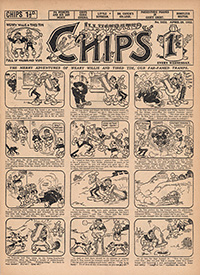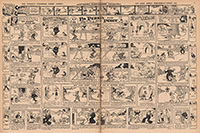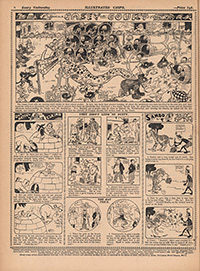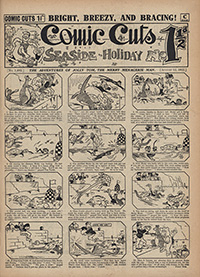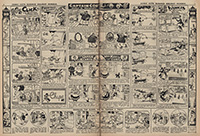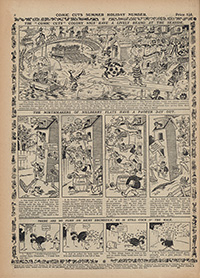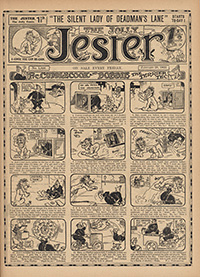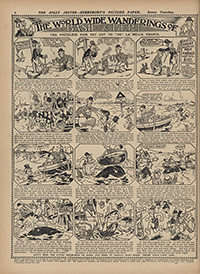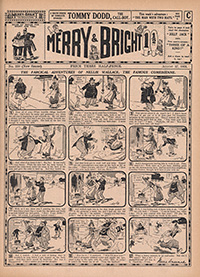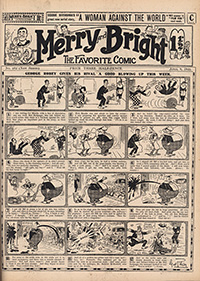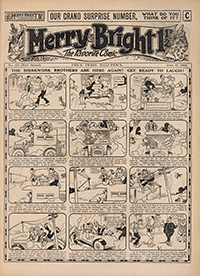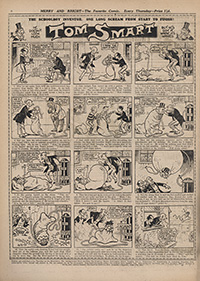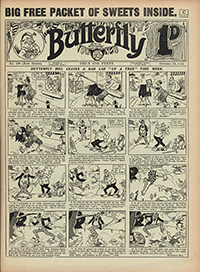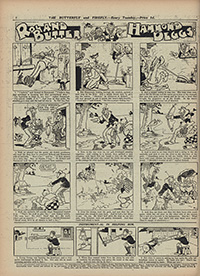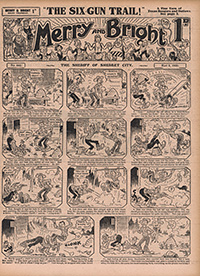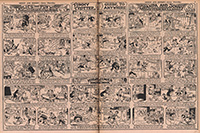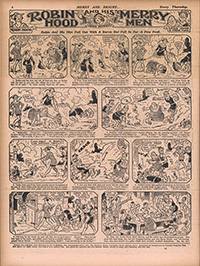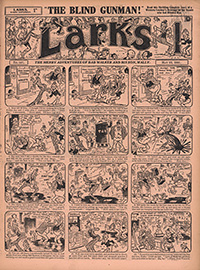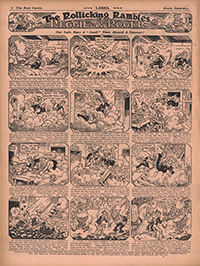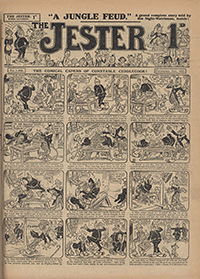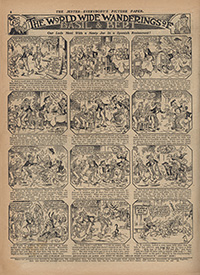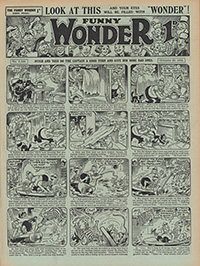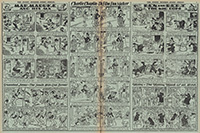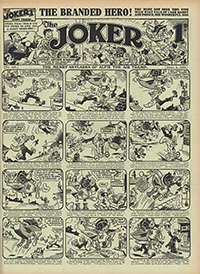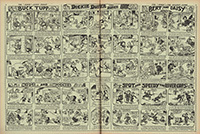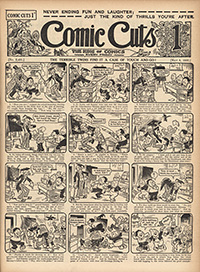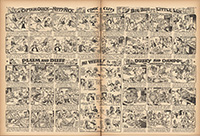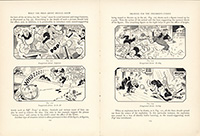Exhibit F1
Illustrated Chips. London: Amalgamated Press. No. 1652. 29 April 1922.
Chips, at this point, has eight pages for 1½ pence (1½ d), the pages arranged in the standard British comics format more
Exhibit F2
Illustrated Chips. London: Amalgamated Press. No. 1652. 29 April 1922.
The dense centre pages of this, a typical 1920s issue of Chips, have a number of short strips running across and down the page more
Exhibit F3
Illustrated Chips. London: Amalgamated Press. No. 1652. 29 April 1922.
On the back page of this issue of Chips: the regular one-panel “Casey Court” by Julius Baker more
Exhibit F4
Comic Cuts Seaside Holiday Number. London: Amalgamated Press. No. 1683. 12 August 1922.
At this time, Comic Cuts also costs 1½ pence (1½ d) for 8 pages (4 pages of strips, 4 pages of 5-column letterpress). more
Exhibit F5
Comic Cuts Seaside Holiday Number. London: Amalgamated Press. No. 1683.12 August 1922.
A dense centre-page spread very similar to the Chips layout. “Click our Sporting Camera Man” by Bertie Brown more
Exhibit F6
Comic Cuts Seaside Holiday Number. London: Amalgamated Press. No. 1683. 12 August 1922.
On the back page of Comic Cuts in the summer of 1922: “The Comic Cuts Colony”, now drawn by Julius Stafford Baker more
Exhibit F7
The Jolly Jester. London: Amalgamated Press. No. 1056. 28 January 1922.
Another A.P. comic costing 1½ pence (1½ d) for 8 pages in the early 1920s, and again: standard British comics format. more
Exhibit F8
The Jolly Jester. London: Amalgamated Press. No. 1144. 6 October 1922.
A “grand new picture serial” starts on the back page of this issue, a 12-panel presentation of the first instalment of “The World-Wide Wanderings of Basil & Bert” more
Exhibit F9
Merry & Bright. London: Amalgamated Press. No. 230 (new series). 27 August 1921.
At first sight, the layout of Merry & Bright seems to differ from the standard British comics format. more
Exhibit F10
Merry & Bright. The Favorite Comic. London: Amalgamated Press. No. 262 (new series). 8 April 1922.
In the early twenties, Merry & Bright specialised in the “farcical funniosities” of contemporary music-hall comedians. more
Exhibit F11
Merry & Bright. The Favorite Comic. London: Amalgamated Press. No. 272 (new series). 17 June 1922.
This issue characterises itself as “Our Grand Surprise Number”, the surprise being that the music-hall comedians have all been dropped, more
Exhibit F12
Merry & Bright. The Favorite Comic. London: Amalgamated Press. No. 272 (new series). 17 June 1922.
On the back page of the revamped Merry & Bright we find “Tom Smart the Schoolboy Inventor" more
Exhibit F13
The Butterfly and Firefly. London: Amalgamated Press. No. 289 (new series). 14 October 1922.
It is autumn 1922. The Amalgamated Press has reduced the price of its “black comics” (as they are now known in the trade) to 1 penny (1d) for 8 pages. more
Exhibit F14
The Butterfly and Firefly. London: Amalgamated Press. No. 288 (new series). 7 October 1922.
On the back page of the fusion comic The Butterfly and Firefly: Roland Butter and Hammond Deggs, two out-of-work actors who never really look for work, more
Exhibit F15
Merry and Bright. London: Amalgamated Press. No. 682. 3 May 1930.
Above: “The Sheriff of Sherbet City”, created by Reg Parlett in 1929. more
Exhibit F16
Merry and Bright. London: Amalgamated Press. No. 682. 3 May 1930.
The centre-page “frolics and fun” includes “Mustava Bunn” drawn by Alex Akerbladh more
Exhibit F17
Merry and Bright. London: Amalgamated Press. No. 682. 3 May 1930.
Robin Hood and his Merry Men swashbuckled their way through a number of British comics in the twenties and thirties, more
Exhibit F18
Larks. London: Amalgamated Press. No. 187. 23 May 1931.
“The Merry Adventures of Dad Walker and his Son, Wally”, a homeless father and son strip, more
Exhibit F19
Larks. London: Amalgamated Press. No. 187. 23 May 1931.
“The Rollicking Rambles of Reggie & Roger”, here in and out of trouble aboard a grain steamer. more
Exhibit F20
The Jester. London: Amalgamated Press. No. 1569. 5 December 1931.
G. M. Payne’s “Cuddy”, or Constable Cuddlecook, ran for 32 years in The Jester more
Exhibit F21
The Jester. London: Amalgamated Press. No. 1569. 5 December 1931.
On the back page of The Jester, the adventures of Basil and Bert are getting more frantic, more
Exhibit F22
Funny Wonder. London: Amalgamated Press. No. 1126. 26 October 1935.
“Pitch and Toss”, invented by Roy Wilson in 1922, here drawn by Reg Parlett. more
Exhibit F23
Funny Wonder. London: Amalgamated Press. No. 1126. 26 October 1935.
The centre-page spread has five comic strips: “Marmaduke and his Ma” drawn by Fred Crompton more
Exhibit F24
The Joker. London: Amalgamated Press. No. 440. 4 April 1936.
The Joker, another Amalgamated Press “black comic”, also conformed to the British comics format. more
Exhibit F25
The Joker. London: Amalgamated Press. No. 440. 4 April 1936.
The centre pages of The Joker (pp. 4–5) have a handful of five-panel strips: “Buck Tupp” by Frank Minnitt more
Exhibit F26
Comic Cuts. The King of Comics. London: Amalgamated Press. No. 2451. 8 May 1937.
“The Terrible Twins” have by now supplanted Tom the Menagerie Man, originally Tom the Ticket-of-Leave Man (see B19 and F4). more
Exhibit F27
Comic Cuts. The King of Comics. London: Amalgamated Press. No. 2451. 8 May 1937.
The centre pages of Comic Cuts in the late thirties have five 8 to 9-panel strips: “Captain Quick and Nippy Nick” drawn by Ray Bailey more
Exhibit F28
Turner, John R. What the Press Artist Should Know. London: Pitman & Sons. 1936.
In this manual for aspiring commercial artists, compiled by John Turner – himself a comics artist, editor and publisher more
